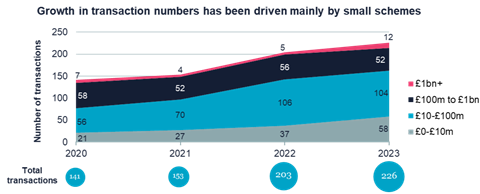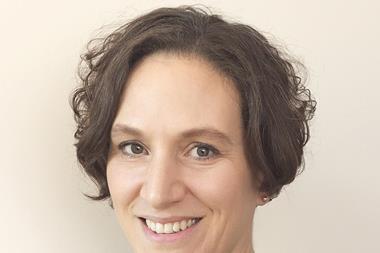More de-risking transactions below £200m are expected despite several consultations over the last year suggesting that UK small schemes are struggling to attract the attention of the insurance market, particularly a consultation on the potential role of the Pensions Protection Fund (PPF) as a public consolidator.
According to Hymans Robertson large transactions above £1bn have dominated the market in 2023.
However, Legal and General’s (L&G) overview of the UK pensions risk transfer market showed that in 2023 it concluded 22 transactions for schemes below £100m, seven transactions for schemes between £100m and £500m and four transactions for schemes above £500m.
According to LCP, 226 transactions were completed in 2023, with transactions below £10m being the “driving force” behind the record number of transactions.
The chart below shows that the number of transactions under £100m more than doubled in the last three years, from 77 in 2020 to 162 in 2023. Buy-ins/outs between £10m and £100m contributed most strongly to the growth in activity seen over 2021 and 2022, but the growth in 2023 was almost entirely driven by deals under £10m.
In contrast, the number of mid-sized buy-ins between £100m-£1bn has been broadly static since 2020, and while transactions over £1bn more than doubled in 2023, they still made up a relatively small proportion of the overall number.
Last November, RSA Group completed a £6.5bn buy-in deal with Pension Insurance Corporation, while L&G completed a £4.8bn buy-in with Boots pension scheme, in what the industry described as one of the largest de-risking transactions.
This year saw Rexam Pension Plan secure the benefits of over 14,000 members of the scheme in a full £1.4bn buy-in with Rothesay, and SCA UK Pension Plan completed a £1.1bn buy-in with L&G.

David Stewart, partner at LCP, said the record number of buy-ins/outs in 2023 was “almost entirely driven” by growth in transactions under £10m, which surged by over 50% last year.
He added: “In 2024, we’re continuing to see a healthy and competitive market for small schemes, with recent LCP-led processes receiving multiple insurer quotations even for schemes below £10m.”
However, he warned that insurers continue to have a low tolerance for under-prepared schemes of all sizes when triaging transaction opportunities – with a focus on avoiding post-transaction costs and log jams.
He said: “The message to smaller schemes is that they can access highly competitive pricing, but they need to be prepared and to work with a specialist adviser with a strong track record of completing deals.”
Streamlined processes
While Hymans believes that large transactions have dominated the market in 2023, it noted that more transactions below £200m are expected as insurers are increasingly standardising and streamlining processes for small deals in an attempt to get more out of their financial and human resources – resulting in better access to the small end of the market.
In April 2024, Pension Insurance Corporation (PIC) launched a streamlined solution, Mosaic, targeting schemes with assets of less than £100m, also in April, Aviva launched Clarity for schemes of less than £100m.
Available on the market is also Just Group’s Beacon solution and L&G’s Flow solution.
Dominic Moret, head of origination and execution for UK pension risk transfer at Legal & General, said that the launch of streamlined processes for small schemes stems from a desire to continue to service this area of the market in an environment of increased demand from schemes of all sizes.
He said: “Insurers are working hard to streamline processes and to make sure they have the resources and technology needed to support growing demand.”
Moret added that the development of L&G’s solution for small schemes – Flow – provides increased efficiency and automation of the quotation, transaction and onboarding process.
Consultants have also introduced streamlined services, including LCP and K3 advisory.
Stewart said that streamlined service has now completed 94 buy-in/out transactions, with 85% of processes since the beginning of last year receiving multiple insurer quotations.
K3 Advisory, meanwhile, advised over 70 schemes on sub-£100m deals since 2019, with more than 40 of these being sub-£10m cases, the smallest being only £0.6m.
Just Group, which focuses on smaller transactions, said it expects to “substantially exceed” its full-year profit target following a surge in small buy-in/buy-out deals.
It said that its sales have grown to £1.9bn as transactions jumped from 35 in the first half of 2023 to 55 in the first half of 2024. The majority of the transactions were under £100m with only five transactions above £100m, according to its half-year report. This compares to 80 transactions for the whole of 2023, when the group wrote over one-third of all transactions in the market.
The group expects a busy second half in 2024, and beyond, “as we execute a pipeline of small, medium and larger transactions, while maintaining capital flexibility”, Just Group said.
New entrants
This year saw three insurers express interest to enter the UK bulk annuity market – Brookfield, Royal London and Utmost.
The general consensus among commentators is that new entrants into the market will open up capacity and generate even more opportunities for competitive pricing.
Arif Saad, head of client advice at Van Lanschot Kempen, said there has been a “big improvement” around how insurers write transactions and the process around it and expects to continue to see innovation in the market pointing out that while sub £100m transactions weren’t “super common” before, are more of a commonplace now.
He said: “I’ve seen more innovation in the last few years than in the last 10 years. That innovation is driven by what’s needed right now. Different things are needed to happen now than things that needed to happen 10 years ago.”
With more options for schemes available such as run-on, the PPF or superfunds, he said that innovation is speeding up and new entrants as well as new solutions will come into the market as insurers try to maintain their market share.
Simon Partridge, head of fiduciary management at Russell Investments, added that new entrants “typically start with smaller schemes” because they tend to be less complex than larger schemes.
He added that new entrants also feel the need to innovate as they enter the market, come up with new pricing structures, new products, new simplified buyout and buy-in options.
He said: “That’s helped drive interest in buyout transactions for small schemes.”
However, while demand for small schemes increases, he expects that demand will remain high for larger schemes with new entrants initially focused on small to medium-sized schemes.
Read the digital edition of IPE’s latest magazine










































No comments yet